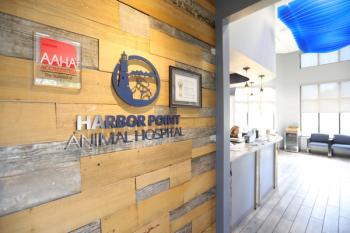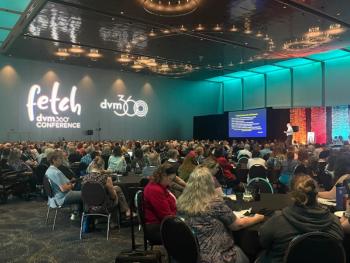
AAHA endorses AAFP position on feral cats
Both associations encourage actions to help resolve massive problem
DENVER—The American Animal Hospital Association (AAHA) endorses the 2004 American Association of Feline Practitioners (AAFP) position statement on free-roaming abandoned and feral cats.
AAHA says that its Board of Directors approved the endorsement following a thorough review.
Dr. Dennis Feinburg, president of AAHA says, "AAHA is very supportive of the comprehensive approach taken by AAFP to address the serious and widespread problem of free-roaming abandoned feral cats. The veterinary profession can play an important role in preventing abandonment and in providing education to clients about responsible cat ownership and feral cat issues," he adds.
The AAFP position encourages and supports actions to provide solutions to the problems associated with free-roaming abandoned and feral cat populations.
AAFP identifies the feral cat problems including quality of life issues for the cats, their impact on wildlife and their potential impact on public health.
AAFP's feral cat position is provided below. For more information go to
AAFP feral cat position:
AAFP encourages and supports actions to provide solutions to the problems associated with free-roaming abandoned and feral cats. These problems include quality of life issues for the cats themselves, their impact on wildlife, and their potential impact on public health.
It is estimated that the number of free-roaming abandoned and feral cats in the United States may be as high as that of owned cats (about 73 million in 2000). Given the high rate of sterilization among owned cats, these unowned cats are the primary source of cat overpopulation. Animal shelters nationwide receive several million unwanted cats each year. Due to a shortage of available homes, approximately 75 percent of these cats are euthanized.
The impact of both owned and unowned free-roaming cats upon the environment is an ongoing subject of debate. Even well-fed cats will hunt and kill prey. These predations cause a significant—and preventable—loss of birds, small mammals, reptiles, and amphibians.
Both owned and unowned free-roaming cats pose small but important threats to human health. Zoonotic agents include rabies virus, Toxoplasma gondii,Bartonella spp., Toxocara cati, Microsporum canis, Cryptosporidium spp., Campylobacter spp., Yersina pestis, Cheyletiella spp., and Francisella tularensis. (A comprehensive summary can be found in the American Association of Feline Practitioners 2003 Report on Feline Zoonoses.) Also, human injury can occur if feral cats are handled without proper precautions or experience. If reportable zoonotic diseases are diagnosed, appropriate health officials must be notified.
Surveys indicate that 7-22 percent of U.S. households feed unowned cats, thus increasing their numbers. Few of these cats have been neutered. Public policies for addressing the free-roaming abandoned and feral cat situation should take into account the lack of public awareness about the seriousness of the problem, the bonding of caretakers to unowned cats, and the growing societal opposition to euthanasia. The veterinary profession can play an important role in preventing abandonment, and in providing education about feral cat issues.
Education
- The AAFP encourages public education campaigns designed to reduce domestic cat abandonment.
- Massive public education campaigns to prevent abandonment will require committed cooperation between state and local government agencies, wildlife organizations, humane associations and veterinary associations.
- Education to prevent abandonment should encourage responsible pet ownership, including the importance of early spaying and neutering, keeping cats indoors, preventing or solving behavior problems, and consulting with veterinarians for information on these issues.
- Public education campaigns should also address the consequences of feeding feral cats, humane solutions (including spaying and neutering) to cat overpopulation, and contact information for groups that can provide assistance.
- Veterinary and technician schools should emphasize the prevention and/or solution of behavior problems and other factors leading to cat abandonment. Feral cat issues should be addressed, with programs in place to help reduce the feral cat population.
The Role of Veterinary Professionals
- Client education is essential to the prevention and/or solution of behavior problems—the primary cause of pet cat abandonment and relinquishment to animal shelters. Veterinary professionals, including educated staff members, can help clients understand:
- The expenses, time and other factors involved in responsible cat ownership.
- What constitutes normal cat behavior, and how to prevent or solve behavior problems.
- How to provide environmental enrichment for indoor cats, including playtime, outdoor enclosures, and walking cats on harnesses and leashes.
- How to properly socialize cats.
- The importance of spaying or neutering cats.
- When obtaining a history, it is important to ask about any behavioral concerns. In addition, clients can be offered information on the problems associated with unowned cats, and how they can be part of the solution.
Public policy
- The AAFP strongly supports reducing the numbers of unowned free-roaming abandoned and feral cats through humane capture (with placement in homes where appropriate) by local health departments, humane societies and animal control agencies. All free-roaming abandoned and feral cats that are not in managed colonies should be removed from their environment and treated in accordance with local and state ordinances.
- State and local agencies are encouraged to promote public policies that:
- Require rabies vaccination of all cats, according to the recommendations of the Compendium of Animal Rabies and Control.
- Require mandatory sterilization of all cats adopted from humane organizations and animal control agencies.
- Promote sterilization of privately owned cats prior to sale or adoption if they are not intended for breeding.
- Encourage microchip identification of all pet cats, and the development of an international universal microchip reader.
- Encourage keeping owned cats indoors, in an outdoor enclosure, or on an attended leash.
- Prevent the establishment of managed cat colonies in areas where cats pose a threat to protected wildlife.
Managed cat colonies
- The AAFP supports appropriately managed cat colonies. Humane alternatives to the destruction of healthy cats for animal control purposes should be actively pursued by veterinary, humane and wildlife organizations. Such alternatives include increased sterilization and humane education.
- The goal of colony management should be the eventual reduction of the colony through attrition; managed colonies are an interim solution to the problem of free-roaming abandoned and feral cats.
- The AAFP opposes placement of managed cat colonies on public lands (except in lawfully permitted areas), in areas where at-risk wildlife could be threatened, or in areas where they may pose a significant zoonotic risk to the public.
- A model feral cat program should include the following elements:
- The goal should be to continually reduce the cat population; however, eliminating the colony may not be achievable due to the immigration of new cats, including the relocation of feral cats from other colonies.
- The colony should be located in an area where the cats do not pose a threat to protected wildlife. The location of the colony should be inconspicuous so as not to encourage abandonment of pet cats. The area should be kept clean, and food left for the cats should be consumed by dark so as not to attract pests and wildlife.
- The colony must comply with local ordinances, and landowner permission must be obtained.
- A monitoring program should be in place to identify new cats joining the colony, as well as cats requiring medical attention. Identification and medical history records should be kept for all cats.
- Ideally, all cats within the colony should be humanely captured in order to receive the following treatments:
- Health examination
- Sterilization
- Rabies vaccination
- Vaccination against feline panleukopenia, feline herpesvirus -1 and calicivirus.
- Identification by ear-tipping
- Testing for feline leukemia virus and feline immunodeficiency virus.
- Adoption of kittens and socialized adult cats if homes are available.
- Return or removal from the colony of cats that cannot be adopted.
- In order to meet the primary objective of reducing cat populations over the long term, programs should be organized to perform the largest number of sterilizations possible. As in other "herd health" situations, services can be prioritized when resources are limited. The largest feral cat programs offer only sterilization, ear-tipping, and rabies vaccinations on the premise that effective cat control will also reduce the transmission of infectious diseases.
- In order to minimize zoonotic disease transmission, the AAFP recommends:
- Immunocompromised and splenectomized persons should not be involved in these programs.
- Program workers should have the knowledge and equipment (i.e. exam gloves, masks and protective eyewear) needed for handling feral cats when necessary. Most cats in managed colonies require little or no handling,
Research
- The AAFP encourages research into the production of an environmentally safe, effective, non-surgical contraceptive for cats.
- The AAFP encourages research that better quantifies the impact of free-roaming cats on human health and the natural environment.
- The AAFP encourages research into the causes of animal abandonment by the public.
Conclusion
Permanent, enduring solutions to the problem of free-roaming abandoned and feral cats will be achievable when:
- State and local governments provide significantly increased funding to animal control agencies.
- An environmentally safe and effective non-surgical contraceptive is developed.
- A massive public education campaign concerning the problems and solutions associated with unowned cats is initiated and sustained.
- Humane, veterinary, wildlife, and public health organizations all work cooperatively toward common solutions.
Newsletter
From exam room tips to practice management insights, get trusted veterinary news delivered straight to your inbox—subscribe to dvm360.




